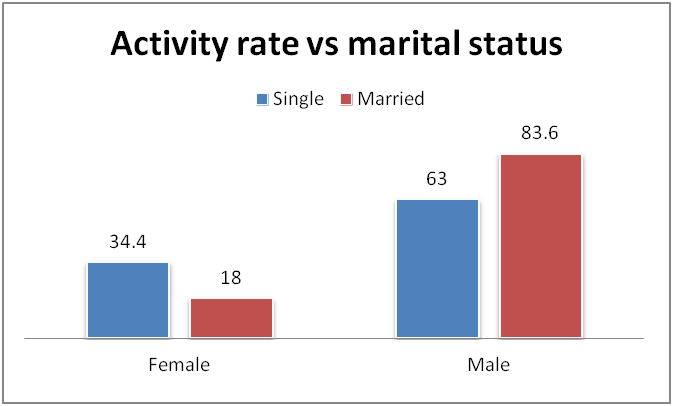TUNESS Chart of the Week (TCW), Monday May 07, 2013
Unemployment is certainly one of the most worrying issues in Tunisia since the revolution. Although many people addressed this topic, few are those who have focused on its impact on women known to be heavier as opposed to men. In the following, we investigate the reasons behind the sensitivity of women's employment to economic shocks. In addition to the revolution of 2011, the Tunisian economy faced few other major events (General Agreement on Tariffs and Trades (GATT ), market liberalization, privatization, the Multi Fiber Arrangement MFA) that affected strongly the sectors employing women.
The women's unemployment rate increased in the last decade despite a sustained economic growth (an average of 5% per year) which resulted is a decrease in the men's unemployment rate (refer to Fig. 1). After the revolution, both male and female unemployment rates increased dramatically but a more serious situation for women is noticed. Also, the activity rate (portion of active people) among women recorded a very slow increase over three decades, from 18.9% in 1975 to 24.4% in 2005 (refer to Fig. 2) although the gender distribution of high school students indicates a greater presence of women (51.12% against 48.88% for boys in 2000) and the legislative framework of Tunisia insures a certain legal equality between man and woman. On the other side, the activity rate for men, significantly higher than that of women, underwent a decline from 81.1% in 1975 to 68.6% in 2005 (refer to Fig. 2). This is related to the phenomenon of school retention which delays the entry of young people into the job market. Overall, the dynamics that have shaped employment in recent years show a greater vulnerability of women's employment to economic shocks. This can be explained by many economic, social, and even cultural aspects.
 The activity rate among women actually varies depending on several factors such as age, education, the place of residence, the marital status etc. First, the activity rate of women is higher in urban than rural areas (26% against 20%) mainly because the sectors that recruit the most, such as manufacturing, tend to implement more frequently in urban areas. This type of industries has been the most affected by some of the economic changes and agreements (e.g. the MFA for clothing and textile industries). Second, a critical characteristic of female labor force is that it is mainly represented by younger age groups. The textile industry recruits mainly unskilled women where two thirds of the employees are aged between 15 and 29. All this, coupled with a context of increased competition between companies, leads to a female labor force with a short duration of the working life and, thus, is less competitive and more sensitive to economic crises. Third, it is socially accepted in Tunisia that the activity rate among women is tightly linked to their marital status.
The activity rate among women actually varies depending on several factors such as age, education, the place of residence, the marital status etc. First, the activity rate of women is higher in urban than rural areas (26% against 20%) mainly because the sectors that recruit the most, such as manufacturing, tend to implement more frequently in urban areas. This type of industries has been the most affected by some of the economic changes and agreements (e.g. the MFA for clothing and textile industries). Second, a critical characteristic of female labor force is that it is mainly represented by younger age groups. The textile industry recruits mainly unskilled women where two thirds of the employees are aged between 15 and 29. All this, coupled with a context of increased competition between companies, leads to a female labor force with a short duration of the working life and, thus, is less competitive and more sensitive to economic crises. Third, it is socially accepted in Tunisia that the activity rate among women is tightly linked to their marital status.
Figure 3 depicts a certain correlation between the activity rate and the marital status (on 1999). While the activity rate of Tunisian women was 23.7%, it reached 34.4% among single women against 18% for married women. The same year, the activity rate among married men was 83.6% against 63% for single. Then, the marital status and more importantly the status within the family (household responsibility) foster the increase of the women's activity rate. Finally, women are generally recruited in a limited number of professions and they are concentrated in a limited number of sectors. Indeed, more than half of the female workforce is concentrated in six professions (women textile workers, secretaries, nurses and midwives, office workers, teachers, and agricultural workers).
Thus, even though women represent a growing proportion of the demand for jobs; the rate of growth of the female labor force is declining. The employment strategies do not seem to go in the direction of a better integration of women into the labor market, and especially with the emergence of social patterns that consider women employment as a second priority.
The reserach is conducted by Mohamed Ben Salah, PhD, TUNESS Research team.
Data source: INS

